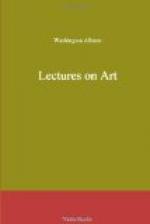Now, though cases may occur where the emotion in question is attended with a sense of security, as in the reading or hearing the description of an earthquake, such as that of 1768 in Lisbon, while we are safely housed and by a comfortable fire, it does not therefore follow, that this consciousness of safety is its essential condition. It is merely an accidental circumstance. It cannot, therefore, apply, either as a rule or an objection. Besides, even if supported by fact, we might well dismiss it on the ground of irrelevancy, since a sense of personal safety cannot be placed in opposition to and as inconsistent with a disinterested or unselfish state; which is that claimed for the emotion as its true condition. If there be not, then, a sounder objection, we may safely admit the characteristic in question; for the reception of which we have, on the other hand, the weight of experience,—at least negatively, since, strictly speaking, we cannot experience the absence of any thing.
But though, according to our theory, there are many things now called sublime that would properly come under a different classification, such as many objects of Art, many sentiments, and many actions, which are strictly human, as well in their end as in their origin; it is not to be inferred that the exclusion of any work of man is because of its apparent origin, but of its end, the end only being the determining point, as referring to its Idea. Now, if the Idea referred to be of the Infinite, which is out of his nature, it cannot strictly be said to originate with man,—that is, absolutely; but it is rather, as it were, a reflected form of it from the Maker of his mind. If we are led to such an Idea, then, by any work of imagination, a poem, a picture, a statue, or a building, it is as truly sublime as any natural object. This, it appears to us, is the sole mystery, without which neither sound, nor color, nor form, nor magnitude, is a true correlative to the unseen cause. And here, as with Beauty, though the test of that be within us, is the modus operandi equally baffling to the scrutiny of the understanding. We feel ourselves, as it were, lifted from the earth, and look upon the outward objects that have so affected us, yet learn not how; and the mystery deepens as we compare them with other objects from which have followed the same effects, and find no resemblance. For instance; the roar of the ocean, and the intricate unity of a Gothic cathedral, whose beginning and end are alike intangible, while its climbing tower seems visibly even to rise to the Idea which it strives to embody,—these have nothing in common,—hardly two things could be named that are more unlike; yet in relation to man they have but one end: for who can hear the ocean when breathing in wrath, and limit it in his mind, though he think not of Him who gives it voice? or ascend that spire without feeling his faculties vanish, as it were with its vanishing point, into the abyss of space? If there be a difference in the effect from these and other objects, it is only in the intensity, the degree of impetus given; as between that from the sudden explosion of a volcano and from the slow and heavy movement of a rising thunder-cloud; its character and its office are the same,—in its awful harmony to connect the created with its Infinite Cause.




